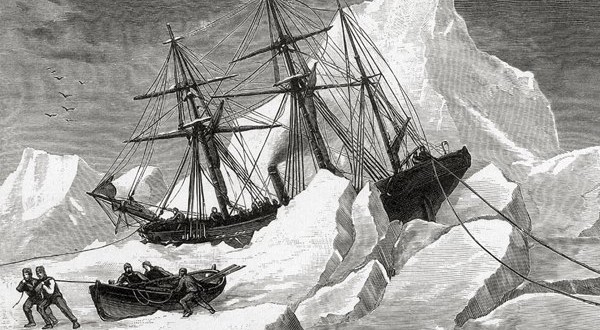For years, scientists have obsessively monitored Arctic sea ice: how it expands in the winter months and how much of it shrinks in the summer. Now, a study that zeroed in on a big chunk of the Northwest Passage, says sea ice there remains too thick and treacherous to be a regular commercial shipping route for decades.
The first-ever study measuring sea ice thickness in the Northwest Passage has found Arctic sea ice is still too thick for ships to safely travel through it year-round. Scientists found that “even in today’s climate, ice conditions must still be considered severe.”
Scientists with York University carried out electromagnetic ice thickness surveys during April and May in 2011 and 2015 to measure the thickness of sea ice over the Northwest Passage — “a system of gulfs, straits, sounds, and channels in the Canadian Arctic Archipelago connecting the Beaufort Sea in the west with Baffin Bay in the east,” according to researchers.
“These show modal thicknesses between 1.8 and 2.0 m in all regions. Mean thicknesses over 3 m and thick, deformed ice were observed over some multi-year ice regimes shown to originate from the Arctic Ocean,” according to the study published by the American Geophysical Union.
“Thick ice features more than 100 m wide and thicker than 4 m occurred frequently,” reads the study. “Results indicate that even in today’s climate, ice conditions must still be considered severe.”
While the study was conducted in late winter, researchers say their results have major implications for potential shipping lanes during the summertime. Winter ice conditions influence spring ice melt, especially for thick sea ice, and change how scientists model Arctic summer ice breakup.
“This is the first-ever such survey in the Northwest Passage, and we were surprised to find this much thick ice in the region in late winter, despite the fact that there is more and more open water in recent years during late summer,” lead researcher Christian Haas said in a statement.
“This points to the importance of ice transport from the high Arctic and melt processes during the spring season, which critically depend on weather conditions and how they affect the melting of thick ice,” Haas said.
Interestingly enough, part of his data comes from late winter 2015 which was marked by rapid sea ice melt. It was “the second lowest April ice extent in the satellite record,” according to the National Snow and Ice Data Center (NSIDC). Low April sea ice extent was followed by sea ice extent that “was at daily record low levels” during May.
But as Haas’ study shows, sea ice extent is only part of the story. What also matters in terms of Arctic navigability is sea ice thickness. Haas notes in his study that “[a]part from ice coverage and ice type, ice thickness is the most important sea ice property required to assess hazard potential and to initialize predictions of ice breakup, deformation, and melt.”
“[B]y all means the observed thicknesses and amount of deformed ice still indicate serious ice conditions which can persist throughout the summers and provide ample potential for encounters with hazardous ice,” Haas writes in his study. “Even in recent years, the [Canadian Arctic Archipelago] remains a source for locally grown [multiyear ice] and a sink for Arctic Ocean [multiyear ice], and therefore, shipping through the [Northwest Passage] should not be taken lightly.”
Though Haas noted his own study supports arguments that the Northwest Passage won’t become “easily navigable for another 40 years or so.”
So what’s the status of the passage right now? NSIDC says both “the Northern Sea Route, along the coast of Russia, and Roald Amundsen’s route through the Northwest Passage are open.”
But of course, this news comes after researchers spent four grueling weeks at sea on an ice-breaker trying to get to the North Pole — and that’s despite it being summertime. NSIDC notes that the “U.S. icebreaker’s capability is far behind that of Russia and other Arctic nations, and plans are ongoing for the U.S. to build a new polar-class icebreaking vessel.”
Agencies/Canadajournal
 Canada Journal – News of the World Articles and videos to bring you the biggest Canadian news stories from across the country every day
Canada Journal – News of the World Articles and videos to bring you the biggest Canadian news stories from across the country every day



